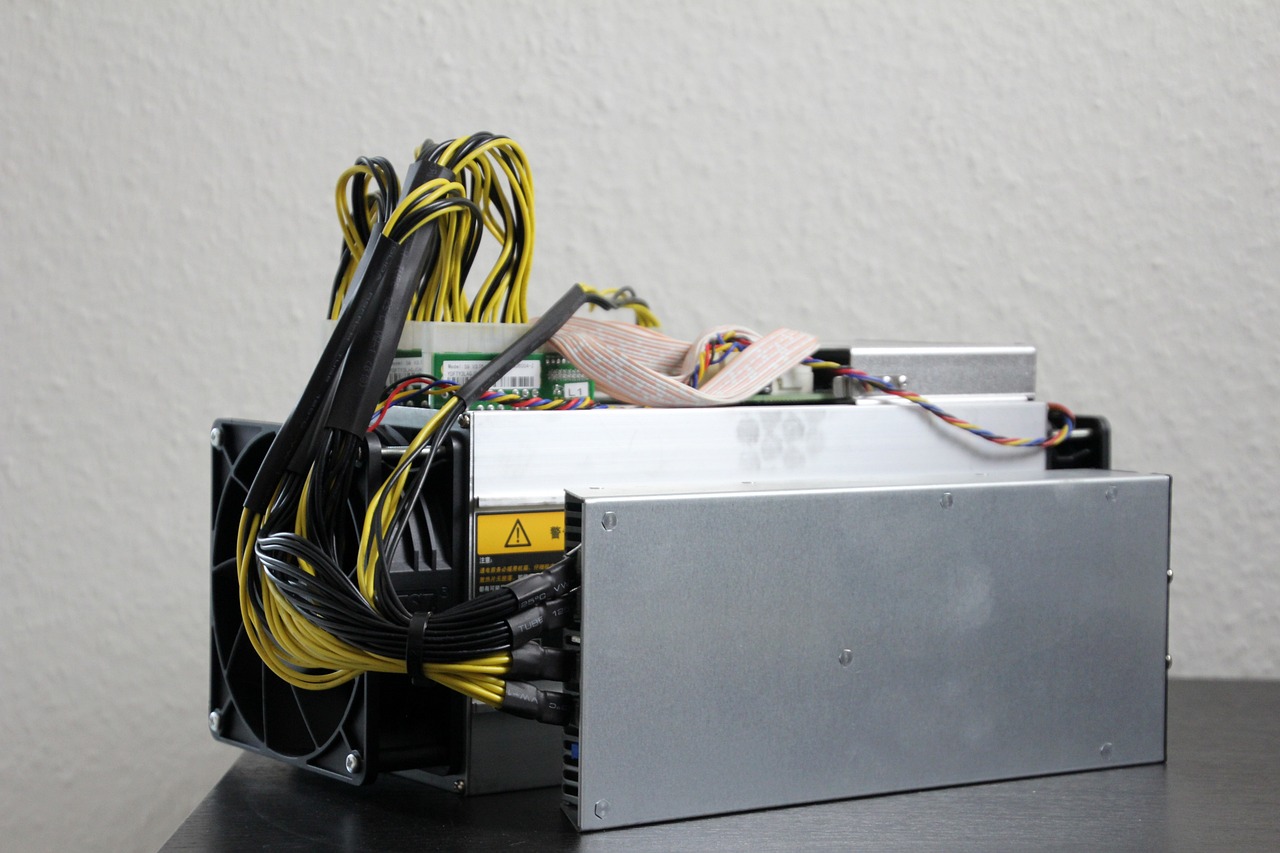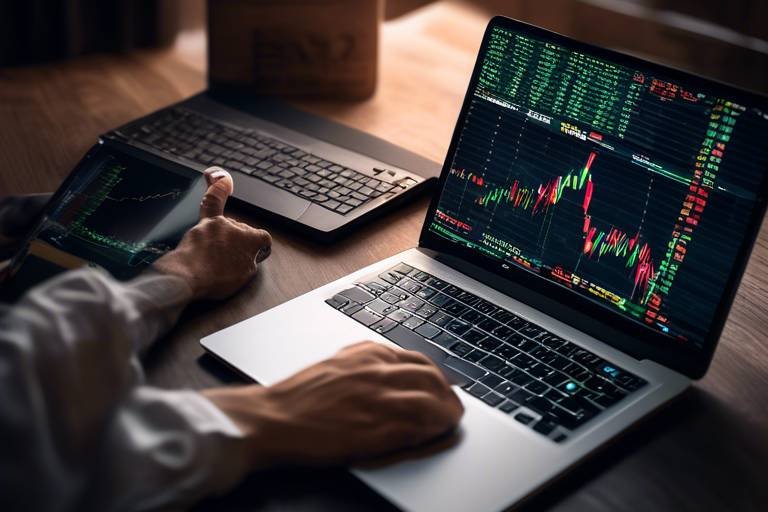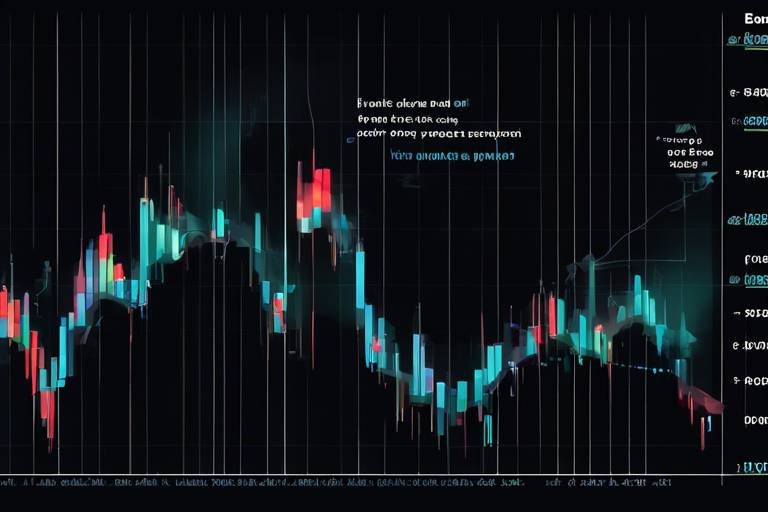Understanding the Role of Algorithms in Crypto Trading
In the fast-paced world of cryptocurrency, where prices can swing wildly in mere minutes, algorithms have emerged as a game-changer for traders looking to capitalize on these fluctuations. But what exactly are these algorithms, and how do they function in the realm of crypto trading? Essentially, algorithmic trading involves the use of computer programs that execute trades based on predefined criteria, allowing traders to automate their strategies and react to market changes at lightning speed. Imagine trying to catch a bus that arrives every few minutes; if you rely on your own timing, you might miss it. However, if you have an automated alert system that tells you exactly when to leave, you’re far more likely to catch that bus. In the same way, algorithms help traders seize opportunities without the delays of human reaction time.
The significance of algorithmic trading in the crypto market cannot be overstated. With the market operating 24/7, traders are often overwhelmed by the sheer volume of data and the speed at which it changes. Algorithms sift through this data, identifying patterns and executing trades based on statistical models. This not only enhances trading efficiency but also helps in minimizing risks associated with emotional trading decisions. In a world where fear and greed can drive market behavior, algorithms serve as a rational counterbalance, making decisions based on logic rather than fluctuating emotions.
Moreover, algorithms can operate continuously without fatigue, processing vast amounts of information in real-time. This capability allows traders to capitalize on fleeting opportunities that human traders might miss. Think of it like having a superpower: while a regular trader might catch a glimpse of a price dip and act on it, an algorithm can detect that dip milliseconds after it occurs and execute a trade instantly. This speed and precision are what make algorithmic trading an invaluable tool in the crypto market.
However, it's important to note that while algorithms can enhance trading strategies, they are not infallible. Market conditions can change rapidly, and algorithms based on historical data may not always predict future movements accurately. Therefore, it's crucial for traders to remain vigilant and continuously refine their algorithms to adapt to the ever-evolving landscape of cryptocurrency trading.
As we dive deeper into this article, we will explore the various types of trading algorithms, their benefits, and the challenges they face. By the end, you'll have a clearer understanding of how algorithms are reshaping the crypto trading landscape, making it more efficient, and what the future might hold for this fascinating intersection of technology and finance.
Algorithmic trading is not just about executing trades; it’s about leveraging technology to create a systematic approach to trading. At its core, it involves using mathematical models and formulas to make decisions about buying and selling assets. This approach can be particularly beneficial in the highly volatile cryptocurrency market, where traditional trading methods may fall short. By employing algorithms, traders can set specific parameters for entering and exiting trades, ensuring that their strategies are executed consistently, regardless of market conditions.
There are several types of algorithms that traders utilize in the cryptocurrency market, each serving distinct purposes. Understanding these types can help traders choose the right strategy for their trading style. The main types include:
- Market-Making Algorithms: These algorithms help maintain liquidity in the market by placing buy and sell orders.
- Trend-Following Algorithms: These algorithms analyze market trends to identify potential profitable trades.
- Arbitrage Algorithms: These algorithms exploit price discrepancies across different exchanges.
In the following sections, we will delve into market-making and trend-following algorithms, exploring their functionality, benefits, and challenges.
Algorithmic trading offers a plethora of advantages that can significantly enhance a trader's performance. First and foremost, speed is a critical factor. Algorithms can execute orders in milliseconds, allowing traders to take advantage of market conditions that may only last for a brief moment. This speed can lead to increased profitability, especially in a market as volatile as cryptocurrency.
Another significant benefit is the reduction of emotional trading. Humans are inherently emotional beings, and trading can often lead to decisions driven by fear or greed. Algorithms eliminate this emotional bias, making trading decisions based purely on data and logic. This rational approach can lead to more consistent results over time.
The efficiency of algorithmic trading cannot be overstated. By automating the trading process, traders can focus on strategy development and market analysis rather than the mechanics of executing trades. This increased efficiency not only saves time but also allows for better resource allocation, enabling traders to explore new strategies and opportunities.
As previously mentioned, one of the most significant advantages of using algorithms is the reduction of emotional decision-making. When traders rely on algorithms, they can trust that their trades are based on solid data rather than fleeting emotions. This shift can lead to a more disciplined trading approach, ultimately improving long-term results.
What are the risks associated with algorithmic trading?
While algorithmic trading offers numerous benefits, it also comes with risks such as system failures, market volatility, and reliance on historical data that may not predict future performance.
Can anyone use algorithmic trading?
Yes, algorithmic trading is accessible to anyone with the right tools and knowledge. However, a solid understanding of market dynamics and programming skills can enhance effectiveness.
How do I get started with algorithmic trading?
To get started, you may want to explore algorithmic trading platforms, learn programming languages such as Python, and study market analysis techniques.

The Basics of Algorithmic Trading
This article explores how algorithms function in crypto trading, their benefits, challenges, and the future of algorithmic trading in the cryptocurrency market.
Algorithmic trading is like having a super-smart assistant who can analyze data and execute trades faster than any human could ever dream of. At its core, algorithmic trading utilizes computer algorithms to automate the trading process, allowing traders to set specific criteria for buying and selling assets. This means that instead of manually monitoring the markets and making split-second decisions, traders can let their algorithms do the heavy lifting.
Imagine you're at a carnival, and you want to win a giant stuffed bear. Instead of trying to throw a ball at a target yourself, you have a robot programmed to throw the perfect shot every time. That's essentially what algorithmic trading does for investors in the cryptocurrency market. It takes the guesswork out of trading by relying on mathematical models and historical data to make informed decisions.
The significance of algorithmic trading in the crypto market cannot be overstated. With the market constantly fluctuating and operating 24/7, traders need a way to stay ahead of the curve. Algorithms can process massive amounts of data in real-time, identifying patterns and trends that might take a human trader hours or even days to notice. This capability not only enhances trading efficiency but also leads to better-informed trading strategies.
In a world where every second counts, algorithmic trading provides a competitive edge. It allows traders to execute orders at lightning speed, ensuring they don’t miss out on potential profits. However, it's essential to understand that while algorithms can be incredibly powerful, they are not foolproof. Market conditions can change rapidly, and algorithms must be continuously monitored and adjusted to respond to new information.
Moreover, the technology behind algorithmic trading is constantly evolving. From high-frequency trading to machine learning, the landscape is always changing, and traders need to stay informed about the latest developments to maximize their success. As we dive deeper into the world of algorithmic trading, we will explore the various types of algorithms, their benefits, and the challenges that come along with them.
Various types of algorithms are employed in crypto trading, each serving different purposes. This section discusses the main types, including market-making, trend-following, and arbitrage algorithms.
Market-making algorithms facilitate liquidity by placing buy and sell orders. This subsection delves into their functionality and importance in maintaining market efficiency.
Market-making algorithms provide advantages like reduced spreads and increased trading volume. This part highlights how they contribute to a healthier trading environment.
Despite their benefits, market-making algorithms face challenges such as market volatility and competition. This section addresses the risks involved in this trading strategy.
Trend-following algorithms identify and capitalize on market trends. This subsection covers how these algorithms operate and their effectiveness in predicting price movements.
Algorithmic trading offers numerous advantages, including speed, accuracy, and reduced emotional bias. This section elaborates on how these benefits enhance trading strategies for investors.
The speed of algorithmic trading allows for rapid order execution, which can lead to higher profitability. This part discusses how efficiency impacts trading outcomes.
Algorithms eliminate emotional decision-making, leading to more rational trading choices. This subsection explores the psychological benefits of relying on algorithms for trading decisions.
- What is algorithmic trading?
Algorithmic trading is the use of computer algorithms to automate trading decisions and execute trades based on predefined criteria.
- How does algorithmic trading work?
Algorithms analyze market data and execute trades at high speeds, allowing traders to capitalize on market opportunities without manual intervention.
- What are the benefits of using algorithms in trading?
Some benefits include increased efficiency, faster execution, reduced emotional trading, and the ability to analyze vast amounts of data quickly.
- Are there risks involved in algorithmic trading?
Yes, risks include market volatility, technical failures, and the need for constant monitoring and adjustment of algorithms.

Types of Trading Algorithms
When it comes to navigating the tumultuous waters of crypto trading, understanding the can be a game-changer. These algorithms are essentially the navigational tools that traders use to make informed decisions, execute trades, and ultimately optimize their trading strategies. Each type serves a distinct purpose, tailored to different trading styles and market conditions. Let's dive into the main types of algorithms that are reshaping the landscape of cryptocurrency trading.
First up, we have market-making algorithms. These algorithms play a crucial role in providing liquidity to the market. Imagine a bustling marketplace where buyers and sellers are constantly interacting; market-making algorithms are like the vendors who ensure that there are always fresh goods available for trade. They achieve this by placing buy and sell orders simultaneously, which helps maintain a balance between supply and demand. By doing so, they not only facilitate smoother transactions but also contribute to a more efficient market environment.
Next, let’s talk about trend-following algorithms. Think of these as the keen-eyed scouts in a trading army, always on the lookout for the next big movement in the market. These algorithms analyze historical data to identify patterns and trends, allowing traders to capitalize on potential price movements. By following the momentum, they can help traders make timely decisions, whether it's riding a bullish wave or avoiding a bearish downturn. Their effectiveness lies in their ability to adapt to changing market conditions, making them a popular choice among many traders.
Then there are arbitrage algorithms, which operate on the principle of exploiting price discrepancies across different exchanges. Picture a savvy shopper who knows that a particular product is cheaper at one store than another; arbitrage algorithms do the same but in the world of cryptocurrencies. They buy low on one exchange and sell high on another, pocketing the difference. This strategy not only helps traders maximize profits but also aids in bringing price uniformity across various platforms.
In summary, the landscape of trading algorithms is diverse and each type serves its unique purpose. Whether it’s enhancing liquidity through market-making, riding the waves of market trends, or capitalizing on price discrepancies, these algorithms are indispensable tools in the arsenal of modern traders. As technology continues to evolve, the sophistication and capabilities of these algorithms are expected to grow, paving the way for even more innovative trading strategies.

Market-Making Algorithms
Market-making algorithms are the unsung heroes of the cryptocurrency trading world. They operate behind the scenes, ensuring that there’s always a buyer for every seller and vice versa. Think of them as the glue that holds the market together, providing liquidity and stability. Without these algorithms, trading could become chaotic, with significant price swings and delayed transactions. These algorithms continuously place buy and sell orders on exchanges, creating a balance between supply and demand. By doing so, they help maintain a healthy market environment, allowing traders to execute their orders with minimal slippage.
These algorithms work by analyzing market data and making split-second decisions based on predefined criteria. For instance, they might look at the order book, recent price movements, and trading volume to determine the optimal prices for buying and selling assets. This capability allows them to react swiftly to market changes, ensuring that they can provide liquidity even during times of high volatility. In essence, market-making algorithms are like skilled chess players, always thinking several moves ahead to anticipate market trends and execute trades accordingly.
One of the most significant advantages of market-making algorithms is their ability to reduce spreads. The spread is the difference between the buying and selling price of an asset, and a narrower spread means lower trading costs for investors. By continuously placing orders, these algorithms help to tighten the spread, making it more cost-effective for traders to enter and exit positions. This is particularly important in the crypto market, where spreads can be wider due to lower liquidity compared to traditional financial markets.
However, it’s essential to recognize that market-making algorithms are not without their challenges. The competitive landscape of algorithmic trading means that many firms are vying for the same opportunities, which can lead to a race to the bottom in terms of pricing. Additionally, market volatility can pose risks for these algorithms. For instance, during sudden price drops, a market-making algorithm might find itself holding onto assets that are rapidly losing value, leading to potential losses. Yet, despite these challenges, the benefits they provide in terms of liquidity and market efficiency cannot be overstated.
To better illustrate how market-making algorithms function, consider the following table detailing their key functionalities and impacts:
| Functionality | Impact |
|---|---|
| Providing Liquidity | Ensures that traders can buy/sell without significant price impact. |
| Narrowing Spreads | Reduces trading costs for participants. |
| Real-Time Data Analysis | Allows for quick decision-making based on market conditions. |
| Risk Management | Helps mitigate risks associated with market volatility. |
In conclusion, market-making algorithms play a crucial role in the cryptocurrency trading ecosystem. They enhance liquidity, reduce trading costs, and contribute to a more stable market environment. As the crypto landscape continues to evolve, these algorithms will undoubtedly adapt and become even more sophisticated, further solidifying their importance in the world of digital assets.
- What are market-making algorithms? Market-making algorithms are automated systems that provide liquidity to the market by placing buy and sell orders based on market conditions.
- How do they benefit traders? They reduce spreads and ensure that traders can execute orders quickly and efficiently, minimizing costs.
- Are there risks associated with market-making algorithms? Yes, they can face challenges such as market volatility and competition, which may lead to potential losses.

Benefits of Market-Making
Market-making algorithms play a crucial role in the cryptocurrency trading ecosystem, and their benefits are as significant as they are varied. One of the primary advantages of these algorithms is their ability to reduce spreads. In simpler terms, the spread is the difference between the buying price and the selling price of an asset. When market-making algorithms are active, they continuously place buy and sell orders, which helps to narrow this gap. This not only makes trading more attractive for investors but also enhances overall market liquidity. Imagine walking into a store where prices fluctuate wildly; it would be frustrating, right? Market-making algorithms bring stability to the often-turbulent world of cryptocurrency trading.
Another noteworthy benefit is the increased trading volume that market-making algorithms generate. By providing liquidity, these algorithms encourage more transactions, which is essential in a market that can sometimes feel like a ghost town. More trades mean more opportunities for investors to enter and exit positions, leading to a healthier trading environment. Think of it as a busy marketplace where sellers and buyers are constantly interacting; the more bustling it is, the better the chances for everyone involved.
Additionally, market-making algorithms contribute to price discovery. This is the process by which the market determines the price of an asset based on supply and demand. With more liquidity and a higher volume of trades, prices can be more accurately reflected. This means that the prices you see are less likely to be influenced by a few large trades and more indicative of the overall market sentiment. In a way, these algorithms act like a compass that helps traders navigate the often-chaotic waters of cryptocurrency markets.
However, the benefits of market-making extend beyond just liquidity and price stability. They also enhance market efficiency. When trades are executed quickly and at the best available prices, the market operates more smoothly. This efficiency is particularly important in the fast-paced world of cryptocurrency, where prices can change in the blink of an eye. With market-making algorithms in play, traders can feel more confident that they are getting the best possible deal, which ultimately fosters trust in the market.
In summary, the benefits of market-making algorithms are profound and multifaceted. They help to reduce spreads, increase trading volume, facilitate price discovery, and enhance market efficiency. As the cryptocurrency market continues to evolve, the role of these algorithms will likely become even more critical. Embracing market-making strategies can lead to a more vibrant and robust trading environment for all participants. So, the next time you think about the mechanics behind your trades, remember how these algorithms work tirelessly behind the scenes to create a better trading experience for everyone involved.

Challenges in Market-Making
Market-making algorithms play a crucial role in ensuring liquidity and efficiency in the cryptocurrency market. However, they are not without their challenges. One of the primary hurdles faced by these algorithms is the inherent volatility of the cryptocurrency market. Unlike traditional financial markets, cryptocurrencies can experience rapid price fluctuations within short time frames. This volatility can lead to significant risks for market-makers, as they may find themselves holding assets that rapidly lose value.
Another challenge is the intense competition among market participants. With the rise of algorithmic trading, many players are utilizing similar strategies, which can lead to market saturation. This saturation can compress profit margins, making it increasingly difficult for market-makers to generate substantial returns. The competition can also result in a phenomenon known as slippage, where the price at which a trade is executed differs from the expected price due to high trading volumes and rapid market changes.
Furthermore, market-making algorithms must constantly adapt to changing market conditions. This requires sophisticated machine learning models and data analysis techniques to ensure that the algorithms remain effective. The need for continuous optimization can lead to increased operational costs and complexity. Additionally, if these algorithms are not properly calibrated, they can exacerbate market movements, contributing to flash crashes or sudden liquidity shortages.
Lastly, regulatory challenges present another layer of complexity. As governments and regulatory bodies around the world begin to scrutinize cryptocurrency trading more closely, market-making algorithms must navigate a landscape that is continually evolving. Compliance with regulations can impose additional constraints on trading strategies, potentially limiting the effectiveness of these algorithms.
In summary, while market-making algorithms are instrumental in enhancing market liquidity and efficiency, they face significant challenges that can impact their performance. Addressing these challenges requires a blend of advanced technology, strategic foresight, and a keen understanding of market dynamics.
- What are market-making algorithms?
Market-making algorithms are automated trading systems that provide liquidity by placing simultaneous buy and sell orders in the market.
- Why is volatility a challenge for market-makers?
Volatility can lead to rapid price changes, increasing the risk of holding assets that may lose value quickly.
- How does competition affect market-making?
Intense competition can compress profit margins and lead to slippage, making it harder for market-makers to succeed.
- What role does regulation play in algorithmic trading?
Regulatory scrutiny can impose constraints on trading strategies, affecting the effectiveness of market-making algorithms.

Trend-Following Algorithms
Trend-following algorithms are like savvy detectives in the chaotic world of cryptocurrency trading. They are designed to identify and capitalize on market trends, allowing traders to ride the waves of price movements rather than getting caught in turbulent waters. Imagine you’re surfing; you don’t want to paddle against the tide. Instead, you want to catch the wave and let it carry you forward. That’s precisely what trend-following algorithms do—they analyze historical price data and use various indicators to predict future movements.
These algorithms operate on the principle that assets which have been moving in a particular direction will continue to do so for some time. This is based on the belief that market psychology plays a significant role in price movements. Traders often follow the herd, and these algorithms tap into that behavior. By utilizing a combination of tools such as moving averages, momentum indicators, and relative strength indexes, trend-following algorithms can generate buy or sell signals, guiding traders on when to enter or exit the market.
One of the most significant advantages of trend-following algorithms is their ability to analyze vast amounts of data at lightning speed. In the crypto market, where prices can change dramatically in mere seconds, speed is crucial. These algorithms can execute trades much faster than a human ever could, ensuring that traders don’t miss out on profitable opportunities. For instance, if a trend is identified, the algorithm can place trades almost instantaneously, often resulting in better prices than those achieved through manual trading.
However, it's essential to recognize that while trend-following algorithms can be incredibly effective, they are not foolproof. Market conditions can change rapidly, and trends can reverse just as quickly as they develop. This is where the risk factor comes into play. Traders relying solely on these algorithms must be prepared for potential losses, especially during periods of high volatility. For example, during a sudden market downturn, a trend-following algorithm might continue to signal buy orders even as prices plummet, leading to significant losses for traders who do not implement proper risk management strategies.
In addition to the risks, it's also important to consider the context in which these algorithms operate. The cryptocurrency market is notorious for its unpredictability, influenced by factors such as regulatory news, technological advancements, and market sentiment. Therefore, while trend-following algorithms can provide valuable insights, they should be used in conjunction with other trading strategies and analysis methods. A balanced approach can help traders navigate the complexities of the crypto market more effectively.
To summarize, trend-following algorithms are powerful tools that can enhance trading strategies by quickly identifying and capitalizing on market trends. They offer speed and efficiency, but traders must remain vigilant and aware of the inherent risks. By understanding how these algorithms work and integrating them into a broader trading strategy, investors can harness the potential of algorithmic trading in the ever-evolving cryptocurrency landscape.
- What are trend-following algorithms?
Trend-following algorithms are automated trading systems that analyze market data to identify and exploit price trends, helping traders make informed decisions based on historical patterns.
- How do trend-following algorithms work?
These algorithms use various technical indicators and historical price data to generate buy or sell signals, executing trades based on predefined criteria.
- What are the risks associated with trend-following algorithms?
While they can be effective, trend-following algorithms are susceptible to market volatility and can lead to losses if trends reverse unexpectedly.
- Can I rely solely on trend-following algorithms for trading?
It's advisable to use trend-following algorithms as part of a diversified trading strategy, incorporating other analysis methods to mitigate risks.

Benefits of Algorithmic Trading
Algorithmic trading has revolutionized the way investors approach the markets, particularly in the fast-paced world of cryptocurrency. One of the most significant advantages of using algorithms is their ability to execute trades with speed and accuracy. Imagine being able to place thousands of trades in the blink of an eye—this is the power of algorithmic trading. By automating the trading process, investors can capitalize on fleeting market opportunities that would be impossible to seize manually.
Furthermore, algorithmic trading reduces the emotional component often associated with trading. When humans are involved, decisions can be clouded by fear, greed, or even fatigue. Algorithms, on the other hand, rely solely on data and predetermined criteria. This leads to more rational and objective trading choices, which can significantly enhance overall performance. In a market as volatile as cryptocurrency, this emotional detachment can be a game changer.
Another notable benefit is the increased efficiency that algorithmic trading brings to the table. Algorithms can process vast amounts of data in real-time, allowing traders to identify patterns and trends that may not be visible to the naked eye. For instance, an algorithm could analyze historical price movements and trading volumes to forecast potential price changes. This level of analysis is not only time-consuming for a human trader but also prone to errors. By leveraging algorithms, traders can make informed decisions quickly and act before the market shifts.
| Benefit | Description |
|---|---|
| Speed | Execution of trades at lightning-fast speeds, allowing for the capture of quick market movements. |
| Accuracy | Minimization of human error, leading to more precise trading decisions. |
| Emotional Control | Elimination of emotional biases, fostering more rational trading behavior. |
| Data Analysis | Ability to analyze large datasets quickly, identifying trends and patterns effectively. |
Moreover, the scalability of algorithmic trading is another compelling advantage. Traders can easily adjust their strategies to accommodate different market conditions or trading volumes without the need for significant manual adjustments. This flexibility allows for a more dynamic trading approach, which can be particularly beneficial in the ever-changing landscape of cryptocurrency.
In addition to these benefits, algorithmic trading can also lead to cost savings. By automating the trading process, investors can reduce the costs associated with human labor and minimize transaction fees through optimized order execution. This financial efficiency can make a substantial difference in overall profitability, especially for high-frequency traders who execute numerous trades daily.
In summary, algorithmic trading presents a myriad of advantages that can enhance trading strategies and improve outcomes for investors. From speed and accuracy to emotional control and cost efficiency, the benefits are compelling. As technology continues to evolve, the role of algorithms in trading will only become more significant, paving the way for innovative strategies that can further capitalize on market opportunities.
- What is algorithmic trading? Algorithmic trading refers to the use of computer algorithms to automate trading decisions based on predefined criteria.
- How does algorithmic trading reduce emotional bias? Algorithms make decisions based on data and logic, eliminating the emotional factors that can cloud human judgment.
- Can anyone use algorithmic trading? Yes, while it requires some technical knowledge, many platforms offer user-friendly tools for traders of all levels.
- What are the risks associated with algorithmic trading? Risks include market volatility, technical failures, and the potential for unintended consequences if the algorithm malfunctions.

Increased Efficiency
In the fast-paced world of cryptocurrency trading, efficiency is not just a buzzword; it's a game-changer. Imagine trying to catch a train that’s already speeding away. If you’re not quick, you miss your chance. Similarly, in crypto trading, the ability to execute trades swiftly can make a significant difference in profitability. Algorithmic trading leverages advanced technology to ensure that orders are executed in a fraction of a second, far quicker than any human could manage. This speed is crucial, especially in a market where prices can fluctuate dramatically within moments.
One of the primary advantages of algorithmic trading is its ability to process vast amounts of data instantaneously. Algorithms can analyze market trends, historical data, and real-time information to make informed decisions. For instance, while a human trader might take several minutes to assess a market condition, an algorithm can evaluate thousands of data points and execute trades based on predefined criteria almost instantly. This real-time analysis significantly enhances the chances of capitalizing on profitable opportunities before they vanish.
Moreover, algorithmic trading reduces the likelihood of human error. Emotional biases can cloud judgment, leading to hasty decisions that might not align with a trader's strategy. Algorithms, on the other hand, operate on logic and pre-set instructions, ensuring that trades are executed based on data rather than emotions. This leads to a more disciplined approach to trading. In fact, studies have shown that traders who rely on algorithms often see a marked improvement in their trading outcomes compared to those who make decisions based on gut feelings or market rumors.
To illustrate the impact of increased efficiency, consider the following table that compares traditional trading versus algorithmic trading:
| Aspect | Traditional Trading | Algorithmic Trading |
|---|---|---|
| Execution Speed | Seconds to Minutes | Milliseconds |
| Error Rate | Higher | Lower |
| Data Processing | Manual Analysis | Automated Analysis |
| Emotional Influence | High | None |
In conclusion, the increased efficiency brought about by algorithmic trading is not just a minor improvement; it represents a fundamental shift in how trading is conducted in the cryptocurrency market. By harnessing the power of algorithms, traders can execute orders faster, reduce errors, and make more rational decisions, ultimately leading to a more profitable trading experience. As the crypto landscape continues to evolve, those who embrace algorithmic trading will likely find themselves at a significant advantage.
- What is algorithmic trading? Algorithmic trading uses computer algorithms to execute trades based on predetermined criteria, enhancing speed and efficiency.
- How does algorithmic trading improve efficiency? It allows for rapid order execution and real-time data analysis, reducing the chances of human error and emotional decision-making.
- Can anyone use algorithmic trading? Yes, many trading platforms offer algorithmic trading tools that can be utilized by both novice and experienced traders.
- What are the risks associated with algorithmic trading? While it offers many benefits, algorithmic trading can also pose risks such as technical failures and market volatility.

Reduced Emotional Trading
One of the most significant advantages of algorithmic trading is its ability to mitigate the influence of emotions on trading decisions. In the fast-paced world of cryptocurrency, where prices can swing wildly in a matter of minutes, it’s all too easy for traders to let fear or greed dictate their actions. Imagine being on a roller coaster—your heart races, your palms sweat, and in that moment of adrenaline, you might make a decision you later regret. This is how emotional trading feels; it can lead to impulsive buys or hasty sells that derail an otherwise sound trading strategy.
Algorithmic trading systems operate on predefined rules and data analysis, which means they execute trades based solely on logic and statistical analysis, rather than human emotions. This is akin to having a seasoned pilot at the controls of a plane, relying on instruments and data rather than the chaotic feelings that might arise during turbulence. By removing the emotional component, algorithms can ensure that trades are executed at the right moment, based on market conditions rather than psychological pressures.
Furthermore, the psychological benefits of algorithmic trading extend beyond just reducing emotional stress. Traders can feel a greater sense of control and confidence knowing that their trades are being executed according to a well-researched strategy. This leads to a more disciplined approach to trading, which is essential for long-term success. Without the emotional roller coaster, traders can focus on refining their strategies and improving their understanding of market dynamics.
To illustrate the impact of emotional trading versus algorithmic trading, consider the following table:
| Aspect | Emotional Trading | Algorithmic Trading |
|---|---|---|
| Decision Making | Impulsive, based on feelings | Logical, based on data |
| Consistency | Inconsistent, varies with mood | Consistent, follows set rules |
| Speed of Execution | Delayed by hesitation | Instantaneous, no hesitation |
| Risk Management | Often neglected | Built into the algorithm |
This table clearly shows how algorithmic trading can enhance decision-making processes by eliminating emotional biases. By adhering to a well-defined algorithm, traders can avoid the pitfalls of emotional trading, such as panic selling during market dips or overenthusiastic buying during price surges.
In conclusion, the reduced emotional trading aspect of algorithmic trading not only fosters a more rational approach to trading but also empowers traders to make informed decisions that align with their long-term investment strategies. As the cryptocurrency market continues to evolve, embracing algorithmic solutions can be a game-changer for those looking to navigate its complexities with confidence and precision.
- What is algorithmic trading? Algorithmic trading involves using computer algorithms to automate trading decisions based on specific criteria.
- How do algorithms reduce emotional trading? Algorithms execute trades based on data and predetermined rules, eliminating the influence of emotions like fear and greed.
- Can anyone use algorithmic trading? Yes, traders of all levels can use algorithmic trading, though a basic understanding of programming and market analysis can be beneficial.
- What are the risks of algorithmic trading? While algorithmic trading can reduce emotional biases, it still carries risks such as technical failures and market volatility.
Frequently Asked Questions
- What is algorithmic trading in the cryptocurrency market?
Algorithmic trading in the cryptocurrency market refers to the use of computer algorithms to automatically execute trades based on predefined criteria. This method allows traders to capitalize on market opportunities quickly and efficiently, without the need for manual intervention.
- What are the main types of trading algorithms?
The primary types of trading algorithms include market-making, trend-following, and arbitrage algorithms. Each type serves a distinct purpose: market-making algorithms provide liquidity, trend-following algorithms capitalize on market trends, and arbitrage algorithms exploit price discrepancies across different exchanges.
- How do market-making algorithms work?
Market-making algorithms work by placing simultaneous buy and sell orders to facilitate liquidity in the market. They help maintain a balanced order book, which is essential for efficient trading. By doing so, they reduce the spread between buy and sell prices, ultimately benefiting traders.
- What are the benefits of using market-making algorithms?
Market-making algorithms offer several advantages, including reduced spreads, increased trading volume, and improved market efficiency. They contribute to a healthier trading environment by ensuring that there are always buyers and sellers available in the market.
- What challenges do market-making algorithms face?
Despite their benefits, market-making algorithms encounter challenges such as market volatility and fierce competition. These factors can affect their performance and profitability, making it crucial for traders to continuously adapt their strategies.
- How do trend-following algorithms operate?
Trend-following algorithms analyze historical price data to identify and capitalize on market trends. They execute trades based on the assumption that prices will continue to move in the same direction, allowing traders to profit from sustained price movements.
- What are the advantages of algorithmic trading?
Algorithmic trading offers numerous benefits, including greater speed, improved accuracy, and reduced emotional bias. These advantages enhance trading strategies by allowing for rapid order execution and more rational decision-making.
- How does algorithmic trading increase efficiency?
The speed of algorithmic trading enables rapid order execution, which can lead to increased profitability. By minimizing delays in trade execution, traders can take advantage of fleeting market opportunities that might otherwise be missed.
- Can algorithmic trading reduce emotional trading?
Yes, algorithmic trading can significantly reduce emotional trading by relying on predefined rules rather than human intuition. This helps traders make more rational decisions, minimizing the impact of fear and greed on their trading outcomes.



















